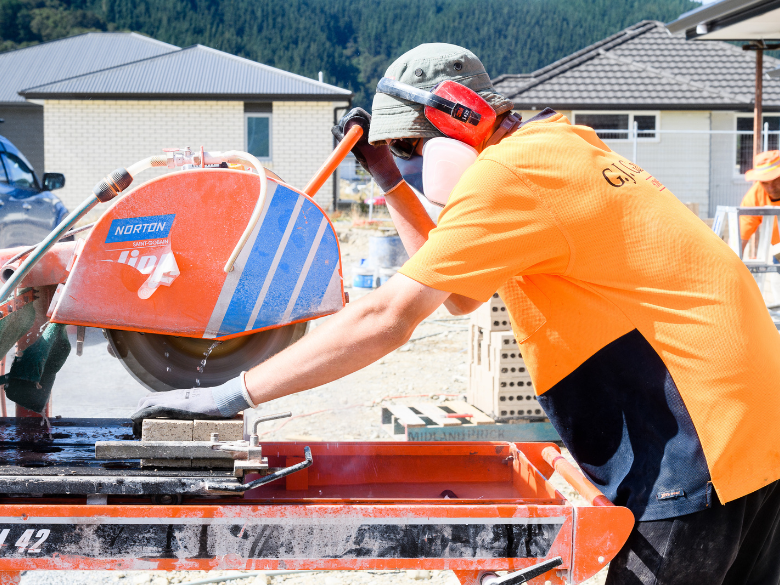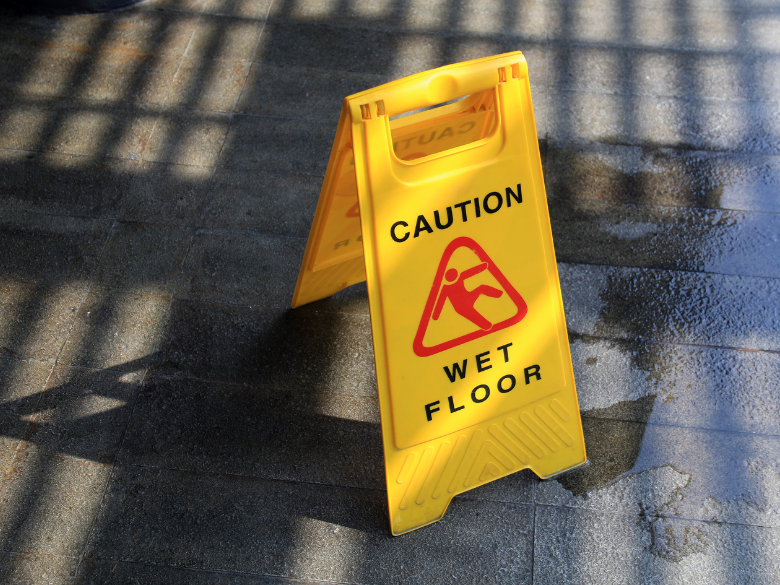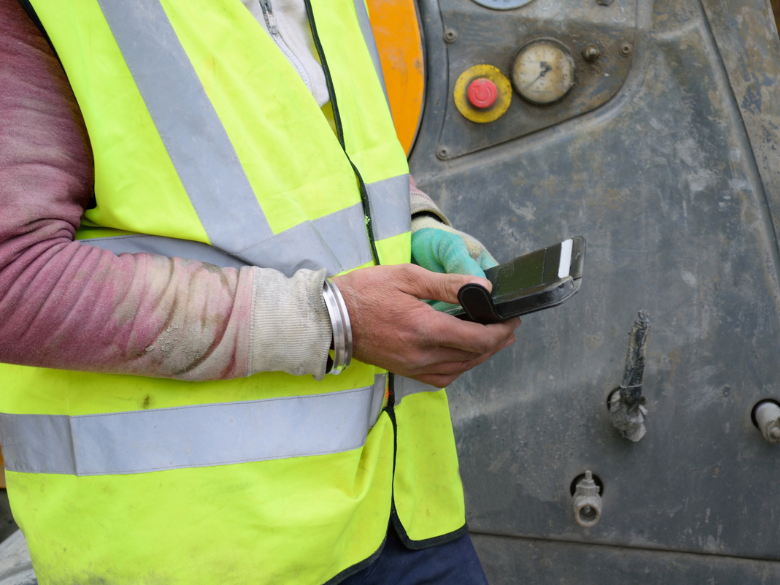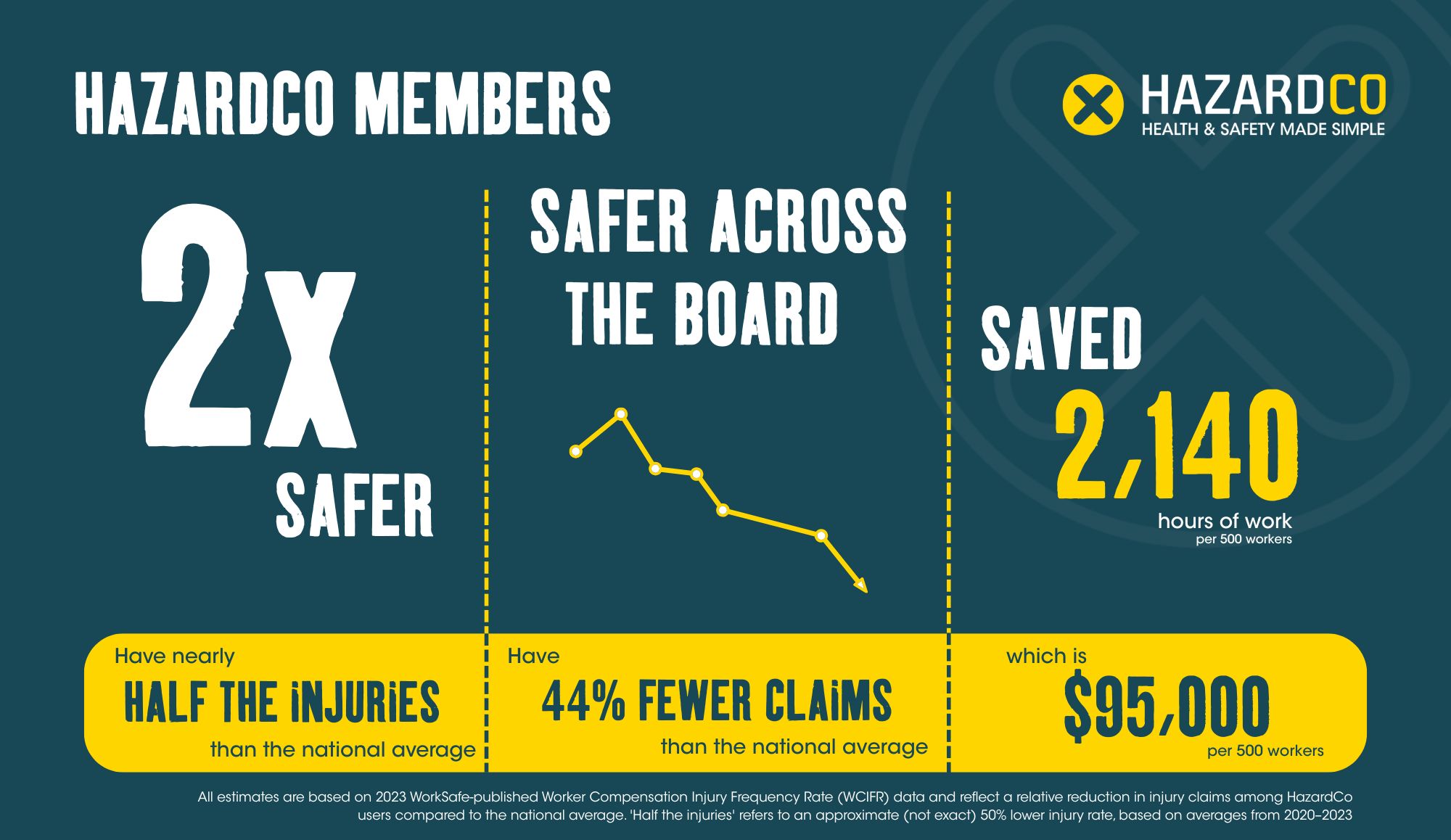
Construction sites come with plenty of obvious hazards but some of the most dangerous ones are the ones you can’t see. One of those hidden risks is respirable crystalline silica dust (RCS), extremely small particles that can be breathed deep into your lungs, increasing the risk of serious lung diseases
If you’re cutting, grinding, sanding, or polishing materials like concrete, stone, brick, or mortar, there’s a good chance you’re creating RCS dust. And while it might not look like much, breathing it in can cause serious, long-term health problems.
When silica dust gets into your lungs, it can cause a disease called Accelerated Silicosis. This is a fast-acting, life-threatening condition that scars the lungs and makes it harder to breathe over time. The tricky part? You might not even notice symptoms until the damage is already done.
That’s why it’s so important to understand the risk and take simple steps to control it.
Safework Australia recommends several ways to reduce exposure and keep your crew safe:
Most people who develop silicosis didn’t realise they were at risk. That’s why it’s vital to talk about RCS, train your team, and make sure everyone knows how to stay safe.
At the end of the day, the goal is simple: everyone goes home safe and healthy.
Want to learn more about managing silica dust on-site? Get in touch with the friendly team at HazardCo. We’re here to help you keep health and safety simple.
Slips and trips might seem harmless, but on-site they’re one of the biggest causes of injuries. A bit of ground clutter, a wet floor, or poor lighting is all it takes to put someone out of action.
Here’s the breakdown:
Businesses must make sure slip and trip hazards are spotted early and dealt with properly. That means checking the site, managing risks, and keeping controls up to scratch.
Reducing slips, trips, and falls starts with simple, practical steps that everyone on-site can take.
Good housekeeping makes all the difference. The HazardCo App has handy checklists to keep your site tidy and safe.
Don’t wait for a near miss to remind you. Start managing slips and trips today and if you need a hand, the HazardCo team is only a call away.
Want an easy way to make your workplace safer without spending a cent? Here’s a simple trick that takes just 30 minutes and can help prevent incidents on the job.
During your next Toolbox Meeting, get everyone to list their top 10 workplace hazards—the things that could go wrong and cause injuries. This could be anything from slippery floors to dodgy equipment or working at heights.
Once everyone’s shared their list, use the HazardCo Toolbox Meeting feature to record and combine the results into a master list of the 10 biggest hazards in your workplace. This makes sure nothing important gets missed and gives your team a clear safety focus.
Now that you know the biggest risks, it’s time to do something about them. This list can help your workplace:
By using HazardCo’s Toolbox Meeting feature, all of this is tracked and recorded, so your team has solid proof of what’s been done to make work safer.
Incidents at work can be serious, but most of them can be prevented. This simple 30-minute exercise gets everyone involved, so safety isn’t just a rule—it’s part of the way your team works. Plus, with HazardCo’s easy reporting tools, you can keep improving and stay ahead of risks before they become real problems.
So next time you are running a toolbox, encourage everyone to speak up – their input could stop someone getting hurt.
If you have any questions, reach out to the HazardCo team. We are always happy to help.
At HazardCo, we’re all about making health and safety simple – and it’s working. New data shows that our members are safer on site compared to the national average. Whether you’re on the tools or managing a team, these numbers show the real impact of doing health and safety the HazardCo way.
There’s a big difference between having a health and safety system and using one that actually works.
At HazardCo, we don’t just help you tick boxes. Our guided tools make it easy to follow the right health and safety steps at the right time — and when that happens, sites are safer. Now we’ve got the data to back it up.
New stats show that HazardCo members are significantly safer on site than the national average. Whether you’re on the tools or running the business, this proves that doing health and safety the HazardCo way pays off.
We’ve crunched the numbers and here’s what we found:
That’s a massive difference.
Why it’s working
Our digital tools make it easy to manage health and safety day to day. From guided Site Reviews that help you put the right controls in place, to risk assessments, toolbox talks, site inductions, SWMS and incident reports — it’s all handled in the HazardCo App.
Everyone on site can get involved, making it easier to spot risks early, take action, and keep things running smoothly. Plus, if something does go sideways, our expert advisors are available 24/7 to help you respond the right way.
When health and safety is easy to follow and part of your everyday routine, it becomes second nature – and it keeps people safer.
Fewer injuries mean less time off the tools, and that saves your business money. When your team stays safe, you avoid costly downtime, keep your jobs on track, and reduce the chance of needing to bring in extra workers to cover.
You’ll also be in a better position if the Regulator (Worksafe / Safework) ever comes knocking. HazardCo helps you meet your legal responsibilities and show you’re doing things properly, without the paperwork pile-up.
A well-run site is a safer site. It’s better for your crew, your schedule, and your bottom line.
Using HazardCo isn’t just about ticking boxes faster, it’s about making your site genuinely safer.
You’re working smarter, with fewer accidents, less downtime, and more time getting the job done right.
Our mission is to keep the person at the top of the ladder safe, and the data shows it’s working.
Not a member yet? Maybe it’s time to make the switch.
We get it — figuring out what to do after an incident or near miss on-site can feel a bit overwhelming. One of the most common things our Advisory Team hears is, “Do I need to report this?”If it’s a notifiable incident, you have a legal duty to let your State Regulator know – Sounds like a lot of paperwork right? Not with HazardCo, our App makes it easy to log an incident or near miss and we’re here to guide you with what to do next!
If someone needs immediate medical treatment for a serious injury, someone’s health and safety was put at serious risk, it might be classed as a notifiable incident. When you report it through the App, we’ll let you know if you need to report it.
Every time you report an incident or near miss, you’re helping make the site safer. It’s not about pointing fingers — it’s about learning from what happened and stopping it from happening again. Everyone on-site has the right to know about any risks, and we all play a part in keeping each other safe.
Creating a culture where everyone feels comfortable reporting issues means better communication and fewer surprises.
It’s easy:
Your report is saved in the Hub and kept on file while you’re a HazardCo member
What happens next?
The App will prompt you to give us a call if needed. Our Advisory Team gets a copy and will:
We recommend:
Keep records
You’re legally required to keep these records for at least 5 years. Logging everything in the App means it’s all saved in the Hub, organised and easy to access if you ever need it.
No one wants accidents to happen on site, but being prepared makes all the difference. Stay calm, follow the steps, and give us a call if you’re unsure. Our Advisory team is available 24/7 for serious incidents.
Got a question? Reach out to us today — we’re here to help.
Hand and finger injuries are one of the most common injuries on-site. Over the last year, HazardCo has received 4599 incident reports – 720 of those were hand or finger injuries. That highlights just how often these injuries happen, so let’s look at how they happen and what we can do to prevent them.
There are plenty of ways hands and fingers can get hurt on-site, but the most common injuries include:
These injuries happen due to faulty equipment, falling objects, getting caught between materials, electrical issues, and simple mistakes.
Many hand and finger injuries occur from everyday tools such as hammers, planes and utility knives, and handling metal sheets. There have also been an increasing number of injuries from nail guns. These injuries are often caused by rushing, fatigue, complacency, using damaged tools, or not having the right training.
Hand injuries aren’t just painful – they affect your ability to work and go about your daily life. Even minor injuries can weaken grip strength and finger movement. More serious injuries could mean permanent damage or loss of function.
Keeping hands safe is all about awareness and good habits. Here’s how you and your team can reduce the risk:
Safety isn’t just about following the rules. It’s about actions and leading by example. Leaders set the tone by demonstrating safe practices, sharing real stories of how hand injuries can impact lives and actively monitoring worksite conditions. Once workers understand the risk, it’s their responsibility to stay aware, but team leaders must make sure safety measures are in place and consistently followed.
Let’s work together to bring those hand injury numbers down!
Got a question about hand safety or any other health and safety issue? The HazardCo Advisory Team is here to help – call 1800 945 702
Anything with wheels and an engine should be at the forefront of your mind on site.
From delivery trucks to excavators, if it moves, and it’s got some weight… then that means power! it’s going to cause some damage if it isn’t controlled. So always keep safety in mind!
Keep pedestrians and vehicles apart
Separate the two wherever you can with careful planning at the design and set up stages.
Minimise vehicle movements
Provide car and van parking away from the work area if possible. Also control entry points, and plan storage areas, so that vehicles don’t need to cross the site where people are.
Turning and reversing vehicles
A spotter wearing high-vis clothing should guide the driver who can’t see clearly behind their vehicle. Mirrors, reversing, warning alarms, sensors and cameras can also make all the difference.
People on-site
When untrained workers drive vehicles without authority, you’re in trouble. Always manage the training and access of drivers to your vehicles, including those visiting.
Visibility
The more the better, just make sure it stands out in the right way. From on-site lighting to aids for drivers (mirrors, CCTV cameras and reversing alarms) to hi-vis clothing for those on the ground. Find out more about the use of hi-vis clothing on-site in our blog here.
Accidents are preventable when risk is managed. How do you manage risk? You get a plan – a good one.
A traffic management plan documents and helps explain how risks will be managed. This might include details of:
Every site is different, but your plan should be monitored and reviewed regularly. It should also be adapted when there are changes to your work situation.
If you have any questions get in touch with the HazardCo team today
We’re excited to announce that HazardCo is officially expanding into the UK! As a New Zealand-born company, we’ve been helping builders and tradies keep their worksites safe since 2007. Now, after years of growth and success in both New Zealand and Australia, we’re ready to bring our trusted health and safety system to the UK market.
Why HazardCo?
At HazardCo, we’re all about making health and safety simple. We know that builders don’t want to spend their time buried in paperwork or worrying about compliance. That’s why we offer digital tools and expert advice to make health and safety easy to manage on-site, in real-time. Whether it’s inductions, risk assessments, or creating safety plans, our system takes the hassle out of health and safety, so builders can focus on what they do best—getting the job done.
Our journey so far
We started in New Zealand, helping Kiwi builders tackle their health and safety challenges. Word spread fast, and soon we had thousands of businesses using our system to stay safe. In 2020, we expanded to Australia, growing to 70 employees and over 10,000 members, including more than 150,000 users actively managing on-site safety through our app.
What’s next?
Now, we’re bringing the same proven system to the UK. We’ve tailored our offering to meet the specific needs of British builders, and our local health and safety experts are ready to provide the support you need. With the recent introduction of the Building Safety Act, there’s never been a more important time for builders to step up their safety game—and we’re here to help make that as simple as possible.
As the construction industry moves toward more digital solutions, HazardCo is ready to help UK builders stay compliant, protect their teams, and keep projects running smoothly.
Ready to take the guesswork out of health and safety? We’ve got your back!
The HazardCo App has a new Plant/Machinery Pre-Start tool! It’s a quick and easy way to do pre-start checks on various plant and machinery such as scissor lists, boom lifts and excavators. Just whip out your app, follow the guided prompts and you’ll know all your reports are saved for safe keeping.
This is a great new tool for those of you currently filling in the log book that stays with the machine, causing lots of painful admin work to gather and compile the information for your own records.
Why conduct pre-start checks?
Pre-start checks are a simple way to check your plant and machinery is up to scratch before it’s used. Whether it’s hired or owned equipment, a quick check will help you to find any potential issues that could impact on the safety of your team or the performance of the machinery. By referring to the manufacturer’s instructions and best practices, workers can make sure the machinery they have is in a safe condition to be used, and if not, the App gives you an easy way to communicate the issues happening on the ground to the right people. When done well pre-start checks go a long way to preventing incidents and equipment failures.
When to use the Plant/MachineryPre-Start tool
The Plant/Machinery Pre-Start tool should be used before the operation of any plant or machinery. You can find it in the main menu of the HazardCo App. Once a pre-start check is completed, the report is automatically saved to the Reports section in the Hub and the App for easy access in the future.
Bennefits for workers: The Plant/Machinery Pre-Start tool provides an easy way to follow pre-start procedures. It helps you to communicate any issues that need to go up the chain and make sure information isn’t lost or misunderstood.
Benefits for workers: This tool is a quicker and easier way to maintain evidence of your crews safe work practises on site. Anyone on site can use the app to complete a Plant/Machinerypre-start, you’ll be able to see it’s been done, and you won’t need to find and scan physical log books anymore!
In light of the recent changes to Australia’s industrial manslaughter laws, we sat down with Glenn, one of our HazardCo Health and Safety (H&S) experts to break down what these laws mean for building companies and tradies.

Q: Glenn, what exactly is industrial manslaughter?
Glenn: Industrial manslaughter is a big deal because it means that if a business owner or someone in charge of a worksite doesn’t take safety seriously, and it leads to a worker’s death, they could be held legally responsible. It’s about accountability. If you knew—or should’ve known—that what you were doing (or not doing) could seriously harm someone, and it ends up causing a death, then we’re talking about industrial manslaughter.
Q: So what’s new with these laws? How are they different from before?
Glenn: The big change here is that industrial manslaughter is now a criminal charge—meaning individuals can face serious charges, and potentially be convicted and face prison time if found guilty. It’s a clear message that safety is non-negotiable. With South Australia and NSW putting in place industrial manslaughter laws this year, and Tasmania pending, they will soon be nationwide.
Q: Who does this law apply to? Is it just for business owners?
Glenn: While business owners are definitely in the spotlight, this law can apply to anyone who has a duty of care on a worksite. So if you’re in a position where you’re responsible for other people’s safety, and your negligence causes a fatality, you could be held accountable. It’s not just about the big bosses; anyone with responsibility for safety needs to be on their game.
Q: Can you give us some examples, Glenn, of how this duty of care might play out on a construction site?
Glenn: Absolutely. In construction, there are plenty of scenarios where this duty of care comes into play. For example, if a site supervisor gives wrong information, tools, or instructions, and a worker is killed, that site supervisor could be facing a charge of industrial manslaughter. It’s the same for contractors—say one builds faulty foundations, and someone ends up getting hurt or worse, that contractor could also be held responsible. And it doesn’t stop there; the PCBU (Person Conducting a Business or Undertaking) might also be on the hook if they didn’t have solid processes in place to ensure the build was up to standard.
Q: What constitutes industrial manslaughter, Glenn? What are the criteria for being charged?
Glenn: To be charged with industrial manslaughter, a few key things need to line up.
First, you have to be a PCBU or an officer of the PCBU.
Second, you must have engaged the individual to work on your site.
Third, you need to be aware of the safety risks they were exposed to.
Fourth, you didn’t do anything about those known risks—whether it’s changing, communicating, or documenting them.
And finally, a fatality has to occur as a result of those risks that you were aware of and failed to address. The main thing that really seals the deal here is what’s called “gross negligence.” Legally, it means that if you have a duty of care, know about a risk, and don’t take action, it becomes much easier to prove negligence. It’s not just about being aware of the risk; it’s about failing to act on it.
Q: This all sounds pretty serious, Glenn. Should businesses be worried?
Glenn: It’s serious, but there’s no need to panic if you’re doing the right thing. The key takeaway is that these laws are here to protect workers. If you’re following safety protocols, keeping your worksite safe, and not cutting corners, then you’re on the right track. The law is only a threat to those who ignore their responsibilities. It’s about doing what’s right, not just for the law, but for the safety of everyone on site.
Q: What steps can businesses take to avoid being charged with industrial manslaughter?
Glenn: There are five simple steps that can really help you stay on the right side of the law—and more importantly, keep everyone safe.
If you have any questions get in touch with the HazardCo team today











